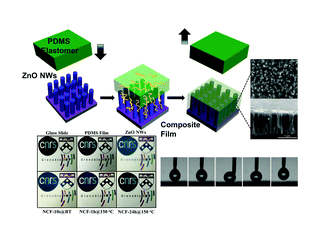
-
- to
Here you will find the paper by Hong Huy Tran
"Nanocomposite films (NCFs) with vertically aligned nanowires (NWs) provide several useful properties owing to their unique morphology. One of the key challenges in producing such an NCF is retaining the vertical alignment of NWs during NCF fabrication. Although current methods such as layer-by-layer assembly and solution-based processes with field-induced alignment of NWs have been successfully demonstrated, these approaches require multiple steps thus are time-consuming, and only suitable for lab-scale production, consequently limiting their widespread applicability. Herein, we describe a new method for fabricating an NCF with vertically aligned ZnO NWs by inducing leaching-enabled capillary rise infiltration (LeCaRI) of uncross-linked and mobile oligomer chains from a poly(dimethylsiloxane) (PDMS) slab into the space between the vertically aligned ZnO NWs. PDMS-infiltrated ZnO NW NCFs have a suite of useful properties including superhydrophobicity, self-cleaning, solvent resistance, and anti-icing properties as well as high transparency and anti-reflection properties. The NCF can easily recover its superhydrophobicity after it has been compromised through repeated plasma treatments or even exposure to intense UV irradiation. Moreover, our approach represents a straightforward, efficient, and potentially scalable strategy to produce multifunctional NCFs with vertically aligned NW arrays which could be easily extended to other types of materials and NW arrangements toward a wide range of properties and applications"


